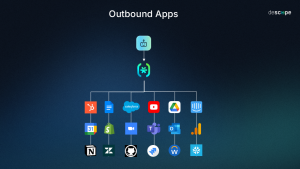And the Truth Will Make You Free
Perhaps even free of your employment.
When Hulu CEO Jason Kilar blogged his “thoughts about the future of TV” on the Hulu website, the reaction was strong: “Is Jason Kilar Trying to Get Fired?” headlined a piece the next day on the WSJ’s All Things Digital site, noting that “some . . . believe Kilar wrote it so that his bosses–executives at News Corp.’s Fox, Disney’s ABC, and Comcast’s NBCU–will give him the hook.”
They same “some” also thought the piece “smart and well-written,” as indeed it is, so there seems to be a disconnect here – if he had written something stupid and turgid, there would be no problem? (The answer, probably, is “yes,” I fear, based on my long experience with organizations.) Hollywood Reporter said he “just might be right about the industry’s future,” but placed no bets on his survival.![]()
So what did Kilar say that aroused the furies? His message had two parts, an appraisal of the business, and a pitch for Hulu.
His appraisal made the point that three basic forces will shape the future of TV:
- TV has too many ads, and consumers will go to great lengths to avoid them, by moving to DVRs and on-demand viewing;
- Consumer want to view TV on their own schedules and on a variety of devices, so the idea of show-it-once is dead;
- Consumers react quickly to shows and movies and can tank them immediately.
Whether the industry likes these developments is irrelevant; they are facts, and “History has shown that incumbents tend to fight trends that challenge established ways and, in the process, lose focus on what matters most: customers. Hulu is not burdened by that legacy.”
Kilar added two more factors to the stew:
- Advertisers are increasingly restive. For 60 years, that had to rely on a show’s projected audience as a “blunt proxy for a certain target audience,” which resulted in “wasted impressions and an often irrelevant experience for consumers.” They are very interested in better targeting.
- Content providers want to make a fair return, and they will give their product to “those distributors that pay the most on a per-user, per-month basis.” It is going to be a dog eat dog world of in which “rapid innovation, low margins, and customer obsession will define the winners in pay TV distribution.”
From these premises he went on to discuss Hulu’s plans and business models, arguing that it is doing fine on ad revenue, averaging more per viewer per half hour than cable or broadcast/DVR, and not far behind bare broadcast. Add in the subscription payments, and Kilar likes his chances. “Hulu will pay content owners and creators more per-user per-month than anyone else. At the same time, we will be able to price our services for consumers lower than anyone else offering the same body of content, given our market-leading ad service and our tolerance for low margins.”
The predictions of Kilar’s departure centered on the truth of his basic observations – for example, imagine telling executives that their business model of stuffing ads is broken! Lese Majeste! My initial reaction to this was “don’t the execs already know that TV is utterly unwatchable? 20 minutes of ads in every hour, capped by five solid minutes before a show’s three minute climactic scene?” My sample of viewers (which is moi) will not watch anything when it is broadcast. It is all DVR or online. Nor will I risk watching a show that is not reasonably available on line for fear I might like it.
The answer is that the execs might well not know. I would bet heavily that they see programs in screening rooms so they don’t have to sit through the commercials. One cause of the downfall of Detroit was that the auto-owning experience of the executives was entirely different from that of their customers. The execs had new cars, perfectly maintained at no inconvenience to them. They had no idea of the fury of their consumers, waiting for tow trucks while sitting in their shoddy, overpriced products. (I once bought a new GM car that broke down on its way home from the dealer and had to be towed back – that was only the beginning of my travail, so 30 years and I still hold a grudge, and buy Japanese.)
The TV execs may well be unaware of how irritating their product has become, and the other points may be equally valid but equally unpleasant to hear. An old business aphorism says that the larger an organization the higher the probabilities that its top management lives in a totally imaginary world, and Kilar’s owners are pretty big. So Kilar may well have told them some things they need to know, and did not know, always a risky proposition.
However, the Kilar-is-toast meme died quickly, and he remains in charge, six weeks later. The latest news is that Hulu may reduce the size of its Board, “which would give the chief executive of the popular online video website, Jason Kilar, more latitude to run the business.” The Board at present has nine members – three each from Disney, Fox, and Providence Equity. (The government required NBC to drop off the Board as part of the Comcast merger.) In the cut, Disney and Fox would each give up a seat. The corporate power dynamic of this tidy-up is not large. It is hard to imagine the representatives of any company splitting their votes, so the entertainment directors as a body remain in control, as before. Of course, there may be internal disputes within companies, so one or another faction may have won out in this change; it is hard to tell from the outside.
But the question that is not getting asked is “who is threatening to fire whom?” Kilar’s memo could be read as saying, “Hulu has a viable business model that will appeal to both content creators and customers. What have you got, and do I really need you? Why shouldn’t content creators start dealing directly with Hulu? Go read your Clayton Christensen on disruptive innovation, and think hard.”
[Cross-posted at Digital Society]
A message from John Furrier, co-founder of SiliconANGLE:
Your vote of support is important to us and it helps us keep the content FREE.
One click below supports our mission to provide free, deep, and relevant content.
Join our community on YouTube
Join the community that includes more than 15,000 #CubeAlumni experts, including Amazon.com CEO Andy Jassy, Dell Technologies founder and CEO Michael Dell, Intel CEO Pat Gelsinger, and many more luminaries and experts.
THANK YOU

















